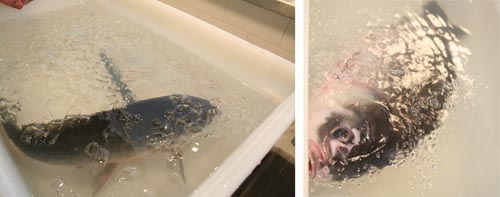posted by Dave Arnold
We were looking for a good fish anesthetic. We figured that knocking fish out prior to killing could improve taste and texture even more than just using our fancy Japanese Ike Jime techniques alone.
Our assumption is that anesthesia reduces stress in fish. Stressed fish make inferior meat. Stress reduces the energy reserves in living muscles. After death, muscles use up their remaining energy and, as a result, go into rigor mortis. The lower energy reserves of stressed muscles lead to a faster, harder rigor than you get in rested muscles. Hard rigor reduces meat quality by reducing flesh firmness and increasing water loss –the forces of rigor literally tear the delicate muscle fibers apart.
We originally tried two different anesthetics: Carbon Dioxide and Nitrous Oxide (aka laughing gas, the dentist’s favorite). Both knocked out the fish, but neither produced good results. We think the fish became agitated before they lost consciousness, negating any possible benefit. You can read the blow-by-blow here.
We have now found a better alternative: Aqui-S. Aqui-S is a fish anesthetic produced in New Zealand. Its active component is isoeugenol –one of the main compounds in clove oil. Clove oil, you may remember, was the tooth numbing stuff given to Dustin Hoffman by Lawrence Olivier’s Nazi doctor character in the Marathon Man. Isoeugenol has some fantastic properties: it is natural, works in low doses, knocks fish out without killing them, is easy to administer, isn’t toxic to us (it is an approved food additive), and, best of all, doesn’t agitate the fish. It has one bad property: it isn’t approved in the United States.

We can’t buy Aqui-S, but we can buy isoeugenol, so we did.
Aqui-S is 50% isoeugenol. The other 50% is stuff to help it disperse in water –it doesn’t want to dissolve on its own. That dispersing aid is proprietary, so we don’t know what it is. Instead we mixed our isoeugenol with 95% ethyl alcohol, which works fine. We tested both carp and striped bass with 17 mg of isoeugenol per liter of water. It worked beautifully on both types of fish. After a couple of minutes, the fish lost their sense of equilibrium and started floating sideways. After 10 to 12 minutes they seemed completely knocked out but were still breathing. Perfect.
We only had one carp, so we couldn’t taste test – but the texture of stripers knocked out with isoeugenol and then killed with spinal cord destruction (Ike Jime) was better than stripers with Ike Jime alone. We were so excited by the results that we called the Aqui-S Company and pleaded with them to send us some of their product “just to test.†Nils and I plan on using it in our Star Chef’s demo next Tuesday (Yes, we will do Ike Jime).
Why isn’t isoeugenol approved in the US?
Oil of clove has been used an anesthetic and as a food and perfume additive for a long-long time. It contains both eugenol and isoeugenol. Recently, the National Toxicology Program of the NIH has called eugenol (not isoeugenol) an “equivocal carcinogen†(meaning maybe a carcinogen, maybe not). The exhaustive study is here. The evidence seems rather weak. Furthermore, the same group didn’t find isoeugenol to be a carcinogen (see here). Also, the amount of isoeugenol we would consume from eating a knocked out fish is low (see here). Nevertheless, the FDA has been hesitant to approve it. Their current opinion is here.
As a final note, here is a paper on the ins and outs of anesthetizing fish.

I believe the final link is broken on this page. I would enjoy reading publication on ins and outs of anesthetizing a fish.
Sorry Chris,
I had an extra http. The link should work now.
Very interesting. I wonder how much of an anesthetic effect the alcohol had on the fish. Enough ethanol can be a very potent anesthetic. I wonder what simply pouring a little Aquavit into the tank would do? Could make for an interesting Skol!
I’m very much looking forward to Starchefs and what you will be doing there.
Thanks John,
The alcohol might have had some effect. I hope not much because I hear it is an irritant to the fish. We didn’t add a lot. I don’t remember the measurements but it was something like 100 grams in a whole lexan of water.
Very interesting indeed… are you going to do further comparisons?
When you tried anesthetizing fish using carbon dioxide in your previous tests, did you buffer the water like the article on anesthetics suggested (pg. 12)? If not, could the stress and irritation caused by the water pH change, as well as the immediate changes in blood pH, be a factor in why those tests produced poor results?
Hi Porter,
We didn’t. That’s a good point. Having spoken to some fish killing experts, however, I’m told that even the pro’s get some thrashing around when using CO2.
I used to work in a fish research laboratory; we always used tricaine. I am not sure of the FDA approval but its worth looking into.
Hi Dave, as a point of interest I know that in Australia, as one example, clove oil/Aqui-S is used to knock out freshly caught eel which is destined both for the domestic and international markets.
Is the quantity of anaesthetic low enough that no clove flavor is imparted to the fish? 17mg sounds pretty low, but clove oil is pretty pungent.
There is no flavor as long as the dose is low enough. Higer doeses can impart a taste.
In addition to your efforts to reduce the stress response, have you looked into using antioxidant additives? There are probably some water soluble antioxidants that won’t irritate the fish. I am assuming that excess oxidization of the fish tissue lowers the quality of the meat. Would you agree with that? Maybe antioxidants could be a complimentary way to approach the problem.
I am a neuroscientist, and many papers I read on fish studies use tricaine. Maybe try it?
I just did a quick wiki search on it. Says it may have toxic breakdown components. Any thoughts?
Does this method work for shellfish?
Yep. Higher dose.
Great read. Do we know of any publications online or otherwise discussing more in detail these practices on lobster?
I don’t know of any publications on the subject, but I’ve done a lot of personal research. I’ve never written about it, because I was supposed to write an article for the NY Times, but never did.
As a curiosity that has to do with the subject, baby eels (“angulas”) have been traditionally killed with some tobacco dissolved in water.